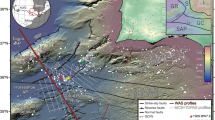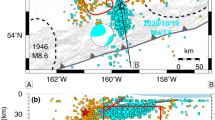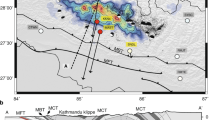Abstract
Many of Earth’s great earthquakes occur on thrust faults1. These earthquakes predominantly occur within subduction zones, such as the 2011 moment magnitude 9.0 eathquake in Tohoku-Oki, Japan, or along large collision zones, such as the 1999 moment magnitude 7.7 earthquake in Chi-Chi, Taiwan2. Notably, these two earthquakes had a maximum slip that was very close to the surface3,4. This contributed to the destructive tsunami that occurred during the Tohoku-Oki event and to the large amount of structural damage caused by the Chi-Chi event. The mechanism that results in such large slip near the surface is poorly understood as shallow parts of thrust faults are considered to be frictionally stable5. Here we use earthquake rupture experiments to reveal the existence of a torquing mechanism of thrust fault ruptures near the free surface that causes them to unclamp and slip large distances. Complementary numerical modelling of the experiments confirms that the hanging-wall wedge undergoes pronounced rotation in one direction as the earthquake rupture approaches the free surface, and this torque is released as soon as the rupture breaks the free surface, resulting in the unclamping and violent ‘flapping’ of the hanging-wall wedge. Our results imply that the shallow extent of the seismogenic zone of a subducting interface is not fixed and can extend up to the trench during great earthquakes through a torquing mechanism.
This is a preview of subscription content, access via your institution
Access options
Access Nature and 54 other Nature Portfolio journals
Get Nature+, our best-value online-access subscription
$29.99 / 30 days
cancel any time
Subscribe to this journal
Receive 51 print issues and online access
$199.00 per year
only $3.90 per issue
Buy this article
- Purchase on Springer Link
- Instant access to full article PDF
Prices may be subject to local taxes which are calculated during checkout



Similar content being viewed by others
References
Dixon, T. H . & Moore, J. C. The Seismogenic Zone of Subduction Thrust Faults (Columbia Univ. Press, 2007)
Tanaka, H. et al. Frictional heat from faulting of the 1999 Chi-Chi, Taiwan earthquake. Geophys. Res. Lett. 33, L16316 (2006)
Fujiwara, T. et al. The 2011 Tohoku-Oki earthquake: displacement reaching the trench axis. Science 334, 1240–1240 (2011)
Ma, K.-F., Mori, J., Lee, S.-J. & Yu, S. Spatial and temporal distribution of slip for the 1999 Chi-Chi, Taiwan, earthquake. Bull. Seismol. Soc. Am. 91, 1069–1087 (2001)
Saffer, D. M. & Marone, C. Comparison of smectite-and illite-rich gouge frictional properties: application to the updip limit of the seismogenic zone along subduction megathrusts. Earth Planet. Sci. Lett. 215, 219–235 (2003)
Abrahamson, N. A. & Somerville, P. G. Effects of the hanging wall and footwall on ground motions recorded during the Northridge earthquake. Bull. Seismol. Soc. Am. 86, S93–S99 (1996)
Bilham, R. & Yu, T.-T. The morphology of thrust faulting in the 21 September 1999, Chichi, Taiwan earthquake. J. Asian Earth Sci. 18, 351–367 (2000)
Brune, J. N. Shattered rock and precarious rock evidence for strong asymmetry in ground motions during thrust faulting. Bull. Seismol. Soc. Am. 91, 441–447 (2001)
Vallage, A., Klinger, Y., Grandin, R., Bhat, H. S. & Pierrot-Deseilligny, M. Inelastic surface deformation during the 2013 Mw 7.7 Balochistan, Pakistan, earthquake. Geology 43, 1079–1082 (2015)
Savage, J. C. The stopping phase on seismograms. Bull. Seismol. Soc. Am. 55, 47–58 (1965)
Oglesby, D. D., Archuleta, R. J. & Nielsen, S. B. Earthquakes on dipping faults: the effects of broken symmetry. Science 280, 1055–1059 (1998)
Madariaga, R. Radiation from a finite reverse fault in a half space. Pure Appl. Geophys. 160, 555–577 (2003)
Brune, J. N. Particle motions in a physical model of shallow angle thrust faulting. Proc. Indian Acad. Sci. (Earth Planet. Sci.) 105, L197–L206 (1996)
Erdogan, F. & Arin, K. A half plane and a strip with an arbitrarily located crack. Int. J. Fract. 11, 191–204 (1975)
Dmowska, R. & Rice, J. R. in Continuum Theories in Solid Earth Physics. Physics and Evolution of the Earth’s Interior Vol. 3 (ed. Teisseyre, R. ) (Elsevier, 1986)
Rudnicki, J. W. & Wu, M. Mechanics of dip-slip faulting in an elastic half-space. J. Geophys. Res. 100, 22173–22186 (1995)
Xia, K., Rosakis, A. J. & Kanamori, H. Laboratory earthquakes: the sub-Rayleigh-to-supershear rupture transition. Science 303, 1859–1861 (2004)
Gabuchian, V., Rosakis, A. J., Lapusta, N. & Oglesby, D. D. Experimental investigation of strong ground motion due to thrust fault earthquakes. J. Geophys. Res. 119, 1316–1336 (2014)
Kozdon, J. E. & Dunham, E. M. Rupture to the trench: dynamic rupture simulations of the 11 March 2011 Tohoku earthquake. Bull. Seismol. Soc. Am. 103, 1275–1289 (2013)
Scholz, C. H. The rupture mode of the shallow large-slip surge of the Tohoku-Oki earthquake. Bull. Seismol. Soc. Am. 104, 2627–2631 (2014)
Suppe, J. Fluid overpressures and strength of the sedimentary upper crust. J. Struct. Geol. 69, 481–492 (2014)
Ide, S., Baltay, A. & Beroza, G. C. Shallow dynamic overshoot and energetic deep rupture in the 2011 Mw 9.0 Tohoku-Oki earthquake. Science 332, 1426–1429 (2011)
Ma, K.-F. et al. Evidence for fault lubrication during the 1999 Chi-Chi, Taiwan, earthquake (Mw 7.6). Geophys. Res. Lett. 30, 1244 (2003)
Allen, C. R., Brune, J. N., Cluff, L. S. & Barrows, A. G. Evidence for unusually strong near-field ground motion on the hanging wall of the San Fernando fault during the 1971 earthquake. Seismol. Res. Lett. 69, 524–531 (1998)
Huang, Y., Meng, L. & Ampuero, J.-P. A dynamic model of the frequency-dependent rupture process of the 2011 Tohoku-Oki earthquake. Earth Planets Space 64, 1061–1066 (2012)
Lykotrafitis, G. & Rosakis, A. J. Sliding along frictionally held incoherent interfaces in homogeneous systems subjected to dynamic shear loading: a photoelastic study. Int. J. Fract. 140, 213–233 (2006)
Lu, X., Lapusta, N. & Rosakis, A. J. Analysis of supershear transition regimes in rupture experiments: the effect of nucleation conditions and friction parameters. Geophys. J. Int. 177, 717–732 (2009)
Acknowledgements
We gratefully acknowledge the National Science Foundation (award number EAR-1321655), which has supported this research. We also acknowledge our colleague, N. Lapusta (California Institute of Technology) for comments and advice. H.S.B. acknowledges K. Kiara and A. Schubnel for inspiring this work.
Author information
Authors and Affiliations
Contributions
A.J.R., R.M. and H.S.B. concieved the study and designed the experiments. V.G. and A.J.R. conducted the experiments. R.M. and H.S.B. conducted numerical modelling studies. All authors contributed to analysis, interpretation and manuscript preparation.
Corresponding author
Ethics declarations
Competing interests
The authors declare no competing financial interests.
Additional information
Reviewer Information Nature thanks C. Scholz and the other anonymous reviewer(s) for their contribution to the peer review of this work.
Publisher's note: Springer Nature remains neutral with regard to jurisdictional claims in published maps and institutional affiliations.
Rights and permissions
About this article
Cite this article
Gabuchian, V., Rosakis, A., Bhat, H. et al. Experimental evidence that thrust earthquake ruptures might open faults. Nature 545, 336–339 (2017). https://doi.org/10.1038/nature22045
Received:
Accepted:
Published:
Issue Date:
DOI: https://doi.org/10.1038/nature22045
This article is cited by
-
Uncertainty Analysis of Dynamic Rupture Measurements Obtained Through Ultrahigh-Speed Digital Image Correlation
Experimental Mechanics (2023)
-
Estimated casualties in possible future earthquakes south and west of the M7.8 Gorkha earthquake of 2015
Acta Geophysica (2019)
-
Full-field Ultrahigh-speed Quantification of Dynamic Shear Ruptures Using Digital Image Correlation
Experimental Mechanics (2019)
-
Pressure shock fronts formed by ultra-fast shear cracks in viscoelastic materials
Nature Communications (2018)
Comments
By submitting a comment you agree to abide by our Terms and Community Guidelines. If you find something abusive or that does not comply with our terms or guidelines please flag it as inappropriate.



